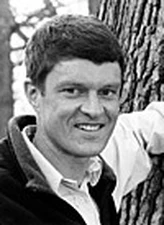Marc Parlange

The 2006 John Dalton Medal is awarded to Marc Parlange for his important work in advancing the concepts of fluid mechanics in land-atmosphere interactions.
One of the fundamental open questions in hydrology is how to describe mass, energy, and momentum exchange rates between heterogeneous landscapes and the atmosphere. Marc’s accomplishments in this domain rank as some of the most original and important over the past 20 years. With his PhD students and faculty colleagues, he co-authored more than 100 peer-reviewed manuscripts in a variety of prestigious journals ranging from hydrology to soil sciences to atmospheric sciences to fluid mechanics to physics and ecology.
He regularly participated and chaired several key research committees in hydrology and atmospheric sciences and served as Co-Editor for Advances in Water Resources, which became (2002-2003) the top impact journal in Water Resources under his leadership. Most recently he became the Editor-in-Chief of Water Resources Research. He has been very active in the EGU. He attended each of the annual meetings for the past 6 years with his entire group of students, and over the past 3 years co-organized a sessions dealing with ‘Scaling and subgrid-scale physics in the geosciences’.
After arriving at the University of California (Davis) Marc immediately branched out to take on a wide range of problems that span the interface between the soil and atmosphere. The breadth of his work was truly amazing and it resulted in a continuous series of major breakthroughs. For example: Marc’s group was the first to show the existence of three distinct sub-layers for humidity in the surface layer; they also quantified the active role of temperature (in contrast to humidity) at small turbulence scales with wavelet statistics.
Marc’s group also worked on a variety of porous media flow problems that ranged from infiltration and subsurface flows at the hillslope and watershed scale to other complex problems that deal with thermodynamics and phase transitions near the soil-atmosphere interface.
He developed and tested a novel computational method that best represent the structure of turbulence responsible for the movement of water vapor, heat and other scalars within the atmosphere. Over the past nine years at the Johns Hopkins University and at the EPFL Lausanne, in collaboration with his colleagues and students, there has been an explosion of spectacular new theoretical and experimental contributions concerning the simulation of the turbulent atmospheric boundary layer over complex terrain. This work has resulted in an entire paradigm shift in field experimentation and the testing of sub-grid scale models. Marc’s group has successfully and creatively utilized rigorous fluid mechanics concepts, methods, and tools to advance a wide range of problems in surface hydrology.
For advancing fluid mechanics concepts in land-atmosphere interactions the 2006 Dalton medal goes to Marc Parlange.
